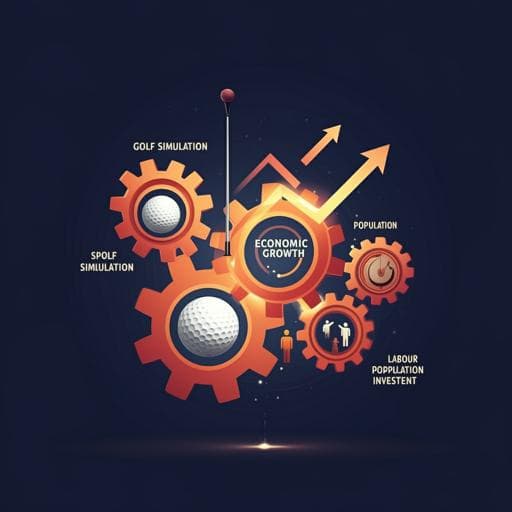
Economics
Economic effect of the golf simulation industry in Korea: an analysis based on the SVAR model
Y. Hao and M. Kong
Explore the dynamic influence of the golf simulation industry on Korea's economic growth from 2000 to 2020. This intriguing research by Yuanyuan Hao and Mengyuan Kong reveals important insights about how this industry interacts with sports investment and labor population, shaping economic outcomes in both the short and long term.
~3 min • Beginner • English
Introduction
The paper introduces golf simulation (screen golf) as a virtual system delivering visual, auditory, and tactile stimuli to replicate real golf play, highlighting its accessibility, low cost, and independence from space and weather constraints. Since the 2000s, IT development has accelerated golf simulation’s integration into education, leisure, and entertainment, supporting professional training and enabling networked competitions. In South Korea, policy support—particularly after 2016 and during COVID-19—helped the golf simulation industry flourish, positioning Korea as a leading country in this domain. Industry statistics show substantial employment, user base, and revenues within the broader sports industry. The study argues that despite the sector’s apparent economic relevance, empirical evidence on its macroeconomic effects is limited. Therefore, it examines how the golf simulation industry relates to Korean economic growth (2000–2020) within a sports-industry perspective using an SVAR framework, focusing on production, added value, and labor effects to inform future industrial development.
Literature Review
Prior research on golf largely addresses skills, course management, tourism, and environmental impacts. Studies document economic benefits from major events and industry specialization, as well as cost drivers of golf tourism, while environmental findings are mixed—some cite ecological fragility, others note biodiversity gains associated with golf courses. With COVID-19 constraining outdoor golf, virtual systems advanced technologically (e.g., sensing methods, mixed-reality swing simulations), improving user experience and performance. Korean studies suggest golf spurs related industries and employment. However, there is a gap in systematic, quantitative, macro-level analyses of the transition from outdoor golf to indoor golf (golf simulation). Much existing work relies on surveys and descriptive observation with strong assumptions and limited empirical grounding. This study addresses the gap by using an SVAR model to analyze dynamic interactions among golf simulation, sports investment, labor, and economic growth in Korea (2000–2020).
Methodology
Data and variables: Annual Korean data for 2000–2020 were compiled from the Korea Sports Industry Report, Statistics Korea, and the World Bank. Four variables (all in natural logs) were used: GDP per capita (LNPGDP) to measure economic growth; golf simulation industry total business income (LNGF) as industry activity; economically active population (LNL) as labor force; and a sports industry investment index (LNSP). Log transformation aimed to improve normality and mitigate heteroskedasticity.
Stationarity and cointegration: Augmented Dickey–Fuller (ADF), DF-GLS, and Phillips–Perron (PP) tests show all series are non-stationary in levels but become stationary after first differencing; all are I(1) at the 5% level. Johansen tests (trace and maximum eigenvalue) indicate two cointegrating relationships among the four variables at 5% significance, justifying a cointegrated SVAR/VECM framework.
Model specification: A Structural Vector Autoregressive (SVAR) model was built to capture contemporaneous relationships and dynamic interactions. The reduced-form VAR lag length was selected using LR, FPE, AIC, SIC, and HQIC; the optimal lag is 1. Stability was verified via inverse roots of the characteristic polynomial within the unit circle.
Identification: Short-run identification used AB-SVAR with Cholesky-type restrictions grounded in economic reasoning: contemporaneously, LNGF does not respond to LNPGDP, LNL, or LNSP; LNPGDP does not respond to LNL or LNSP; and LNL does not respond to LNSP in the current period (specific zero restrictions placed on contemporaneous coefficient matrices). Long-run identification followed Blanchard–Quah style restrictions by constraining certain long-run cumulative responses to zero (upper-triangular long-run impact matrix), distinguishing permanent from transitory effects.
Estimation and inference: The study computed impulse response functions (IRFs) under both short-run and long-run schemes over 10 periods, with confidence intervals via a recursive-design wild bootstrap. Forecast error variance decompositions (FEVD) quantified contributions of each structural shock to the variability of each variable over horizons up to 10 periods. Robustness included model stability checks and absence of serial correlation.
Key Findings
- Stationarity/cointegration and lag selection: All series are I(1). Johansen tests indicate two cointegrating vectors at 5%. The optimal VAR/SVAR lag length is 1, and stability conditions are satisfied (inverse roots inside unit circle).
- Short-run impulse responses: There is a strong short-run correlation among the golf simulation industry (LNGF), sports industry investment (LNSP), and labor (LNL). The interaction between LNGF/LNSP and GDP per capita (LNPGDP) is weaker and somewhat uncertain in direction under short-run shocks. LNGF shocks generally elicit positive responses in itself, with mixed short-lived effects from other variables; LNSP initially exerts a temporary negative effect on LNGF before turning positive. LNL shocks imply that LNGF and LNSP can raise employment in the short term, though effects fluctuate. LNPGDP responds positively to its own and LNSP shocks (L-shaped), while initially negative effects from LNGF and LNL turn positive over time.
- Long-run impulse responses: Under long-run constraints, unidirectional positive effects emerge linking LNGF, LNSP, LNL to LNPGDP, with persistent but less volatile and overall weaker interactions than in the short run. Economic growth delivers sustained positive effects on itself and related sectors.
- Variance decomposition (period 10, illustrative stabilized shares):
• LNGF variance explained by: own shocks ≈ 93.95%, LNPGDP ≈ 0.46%, LNL ≈ 0.90%, LNSP ≈ 4.69%.
• LNPGDP variance explained by: own ≈ 57.50%, LNGF ≈ 32.68%, LNL ≈ 7.81%, LNSP ≈ 2.01%.
• LNL variance explained by: own ≈ 47.51%, LNGF ≈ 15.95%, LNPGDP ≈ 26.29%, LNSP ≈ 10.26%.
• LNSP variance explained by: own ≈ 28.57%, LNGF ≈ 26.55%, LNPGDP ≈ 33.58%, LNL ≈ 11.30%.
These FEVD results indicate that economic growth variability is driven mainly by its own shocks and by the golf simulation industry, while labor and sports investment contribute modestly but positively. LNGF dynamics are dominated by own shocks with a measurable role for LNSP; LNL is influenced by itself as well as LNGF and LNPGDP; LNSP reflects significant contributions from LNPGDP, LNGF, and itself.
Discussion
The findings support long-term shock interactions among the golf simulation industry, economic growth, sports investment, and labor—contributing to literature that previously focused on outdoor golf’s effects on the economy, tourism, and environment while overlooking industry restructuring toward indoor golf. Economic growth exhibits positive, sustained, and externally beneficial effects, stimulating related industries and labor demand. Market structure analysis suggests the golf simulation industry is in a decentralized, regionally differentiated, monopolistic competition environment with a U-shaped evolution of market concentration, driven by regional clustering of labor and sports investments. COVID-19 accelerated a shift from outdoor to indoor golf, with Korean practitioners innovating business models, which aligns with the observed positive long-run links to growth. Overall, the results imply that while short-run interactions can be volatile and uncertain, long-run effects align in a positive direction, especially from golf simulation and sports investment toward economic growth, reinforcing the role of the sector in Korea’s broader industrial and macroeconomic landscape.
Conclusion
This study constructs an SVAR framework using Korean annual data (2000–2020) to analyze the economic effects of the golf simulation industry in conjunction with labor, sports investment, and GDP per capita. Tests confirm I(1) integration, two cointegrating relations, an optimal lag of one, and model stability. Impulse responses reveal strong short-run links among LNGF, LNSP, and LNL and weaker, more uncertain short-run connections with GDP; long-run constraints show unidirectional positive effects of LNGF, LNSP, and LNL on GDP with persistent but less volatile interactions. Variance decomposition indicates GDP variability is driven largely by its own shocks and by LNGF, while LNSP and LNL also contribute positively. These results suggest the golf simulation industry positively contributes to Korea’s economic growth and plays a nontrivial role in the sports industry structure.
Policy recommendations include: (1) shifting marketing strategies beyond traditional on-course customers to broaden the customer base and foster new growth; (2) transforming the customer base from high-end to include middle- and low-income groups through community-based access points (e.g., training colleges, entertainment venues) to expand participation; and (3) diversifying business strategies to link golf simulation with outdoor golf and tourism, leveraging venues such as hotels, parks, malls, and hospitals to maximize practicality and economic benefits. The study underscores supporting SMEs and fostering integration between golf simulation and related sectors to sustain positive economic externalities and inclusive growth.
Limitations
The authors note that the research has limitations and is based on statistical methods and econometric modeling using secondary data (no primary data were collected). Specific limitations are not elaborated in detail. They suggest that future work could further examine the golf simulation industry’s broader social and cultural impacts and potentially inform policy for simulated sports industries more generally.
Related Publications
Explore these studies to deepen your understanding of the subject.







